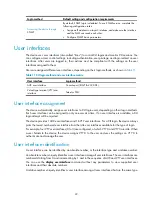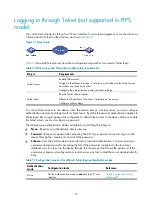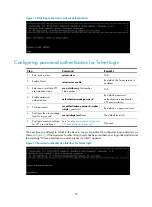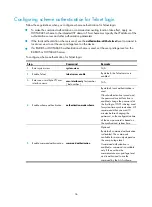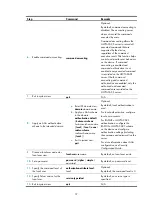
33
Logging in through Telnet (not supported in FIPS
mode)
You can Telnet to the device through a VTY user interface for remote management, or use the device as
a Telnet client to Telnet to other devices, as shown in
Figure 11
Telnet login
shows the Telnet server and client configuration required for a successful Telnet login.
Table 14
Telnet server and Telnet client configuration requirements
Object Requirements
Telnet server
Enable Telnet server.
Assign an IP address to a Layer 3 interface, and make sure the Telnet server
and client can reach each other.
Configure the authentication mode and other settings.
Telnet client
Run the Telnet client program.
Obtain the IP address of the Layer 3 interface on the server.
Configure other settings.
To control Telnet access to the device when the device acts as a Telnet server, you can configure
authentication and user privilege levels for Telnet users. By default, password authentication applies to
Telnet login, but no login password is configured. To allow Telnet access to the device after you enable
the Telnet server, you must configure a password.
The following are authentication modes available for controlling Telnet logins:
•
None
—Requires no authentication and is insecure.
•
Password
—Requires a password for accessing the CLI. If your password was lost, log in to the
device through the console port and re-set the password.
•
Scheme
—Uses the AAA module to provide local or remote authentication. You must provide a
username and password for accessing the CLI. If the password configured in the local user
database was lost, log in to the device through the console port and re-set the password. If the
username or password configured on a remote server was lost, contact the server administrator for
help.
Table 15
Configuration required for different Telnet login authentication modes
Authentication
mode
Configuration tasks
Reference
None
Set the authentication mode to
none
for the VTY user
interface.
"




